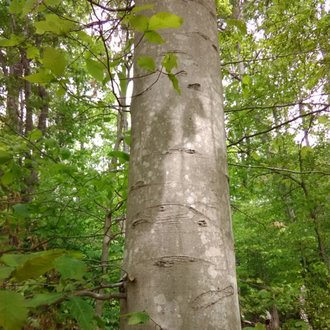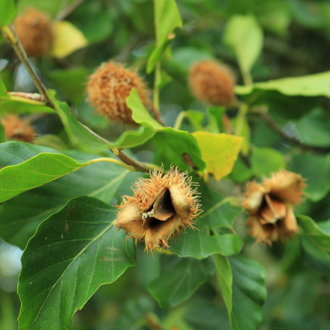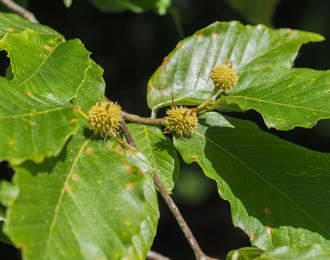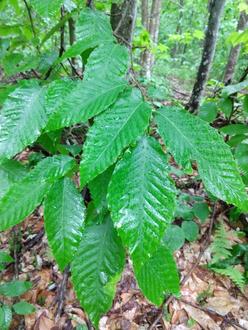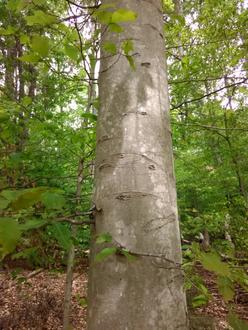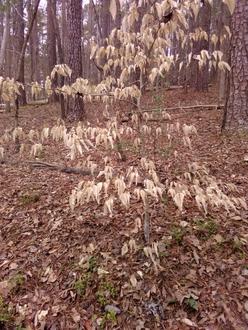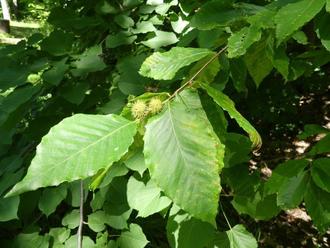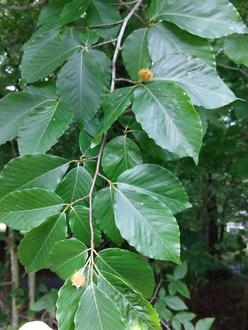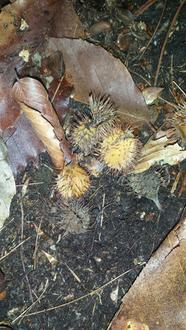American Beech (Fagus grandifolia Ehrh.)
↑Summary
A shade-tolerant tree representing a climax species in hardwood forests of eastern North America.
↑Range - Expand
| Legend | Color |
| Native or Not Present | |
| Native |
This tentative map is based on our own research. It may have limited data on Canada and/or Mexico, and there is some subjectivity in our assignment of plants as introduced vs. expanded. Read more in this blog post.
Although this plant occurs somewhere in each of these regions, it may only occur in a small part of some or all of them.
↑Description & Identification
A large tree with very smooth gray bark, even on mature trees.
↑Similar Plants
↑Habitat
Found in forests; considered a climax species and usually only found in mature forests in the later stages of succession.
Prefers a specific range of temperature conditions. Found at lower elevations in the north part of its range, and at higher elevations in the south. Towards the south of its range and towards lower-elevation areas within a specific area, it shows a preference for cooler north- and east-facing slopes, whereas towards the north and at higher elevations, it is found more on warmer south- and west-facing slopes.
In the south of its range, at low elevations, sometimes found in well-drained portions of floodplains where moisture is abundant.
Has a preference for some soils types. Commonly found on podzols, soils that commonly form under coniferous forests, and also on laterite soils, soils rich in iron, aluminum, and clay which are more common farther south. In the north, mostly found on coarse-textured soils that dry out more easily. Generally absent from limestone soils and other calcium-rich soils.
Highly vulnerable to fire and only found on areas that have not burned in a long time.
↑Life Cycle
American beech is a shade-tolerant canopy tree that is often associated with climax communities, especially those protected from fire. The thin bark and shallow roots of this species make it particularly susceptible to fire, even low-intensity fires that spare most other tree species. Seedlings and saplings are most vulnerable to fire.
Seedlings and saplings can persist for years as understory plants, quickly growing to full size when a gap develops.
Flowers in spring; flowers are wind-pollinated.
Beech is a masting tree, producing large crops of nuts in some years and only negligible amounts (most nuts consist of empty shells) in other years. Mast frequency is irregular, ranging from 3-8 years (source) and depends on weather conditions. Flowers can be damaged by late frosts. Nuts are spread by birds and other animals.
When cut, can resprout from roots. Sometimes forms vegetative colonies, especially where trees have been cut, but under normal conditions most reproduction is by seed.
↑Faunal Associations
The mast of this species was one of the primary foods of the once-abundant and now-extinct passenger pigeon (Ectopistes migratorius). Deforestation, including loss of this tree specifically, played a major role in this bird's extinction.
The seeds are also eaten by the White-footed mouse (Peromyscus leucopus), whose populations increased following the extinction of the passenger pigeon (source).
This species is attacked by an introduced insect, the beech scale insect, Cryptococcus fagisuga.
↑Uses
American beech is an important source of wood.
The smooth bark often attracts people looking to carve in it.
It is infrequently planted as a landscaping tree; its surface roots can be a nuisance in gardens or near sidewalks.
The nuts are edible but are neither cultivated nor widely consumed, possibly due to their small size and irregular production, and possibly due to the slow growth of this species not lending itself to cultivation for nuts. The European beech also has significantly larger nuts.
↑Related Plants
Fagus grandifolia is the only beech species in most of its range. The closely related Mexican beech is sometimes treated as its own species (Fagus mexicana) but usually treated as a subspecies (Fagus grandifolia subsp. mexicana).
The European beech, Fagus sylvatica, is widely planted as a landscaping plant, has become established in the wild in several locations in North America, mostly in the Northeast.
The broader Fagaceae family includes many genera with species overlapping in range with the American beech, including a few species of Castanea (chestnut), and many species of Quercus (oak), and several other genera which are mostly found on other continents.
↑Notes
This species is a forest canopy tree that makes up one of the largest components of forests in many parts of eastern North America. It is particularly dominant in beech-maple forests, closely associated with sugar maple, and also occurs in many other forest types.
↑Links & External Resources
• American Beech | The Wood Database (About This Site)
• American Beech | Fire Effects Information System (FEIS) (About This Site)
• Fagus grandifolia (American Beech) | Illinois Wildflowers (About This Site)
• Fagus grandifolia (American Beech) | USDA PLANTS Database (About This Site)
• Fagus grandifolia | Go Botany (About This Site)
• Fagus grandifolia (American Beech) | Missouri Botanical Garden Plant Finder (About This Site)
• American Beech | Virginia Tech Dendrology Factsheets (About This Site)
• American Beech | Silvics of North America (About This Site)
• Fagus grandifolia | Biota of North America Project (BONAP) (About This Site)
• Fagus grandifolia | NatureServe Explorer (About This Site)
• Fagus grandifolia | Flora of North America (About This Site)
• Fagus grandifolia | Missouri Plants (About This Site)
• American Beech | Maryland Biodiversity Project (About This Site)
• Fagus grandifolia Ehrhart (American Beech) | Digital Atlas of the Virginia Flora (About This Site)



